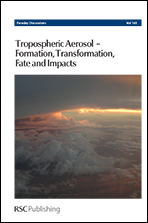Concluding remarks: challenges for aerosols and climate
Abstract
We study aerosols for many reasons, including their effects on human health and climate. For climate, it is important to distinguish between the overall radiative effect of aerosols and the radiative forcing, which has been the anthropogenic change (after rapid atmospheric adjustments) since pre-industrial times. The radiative forcing is in principle much harder to observe than the overall effect because one must understand which particles are natural in today's atmosphere and what aerosols were like in the atmosphere before large-scale human influence. Because we cannot go back and measure the past, the only way to calculate radiative forcing may often require modeling detailed aerosol processes. This is a motivation for many of the processes studied at the Faraday Discussion 165. Other processes may need more attention by the aerosol climate community.
- This article is part of the themed collection: Tropospheric Aerosol – Formation, Transformation and Impacts

 Please wait while we load your content...
Please wait while we load your content...